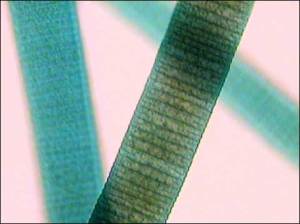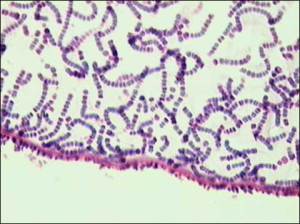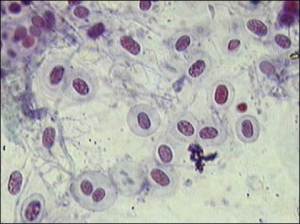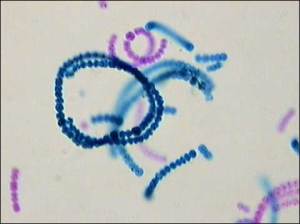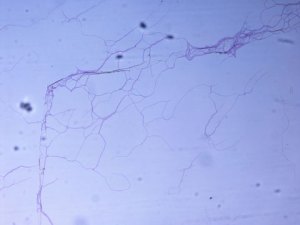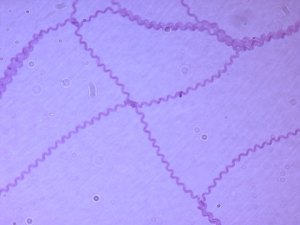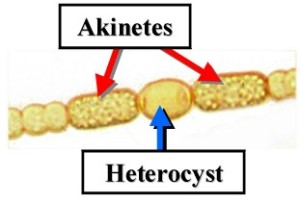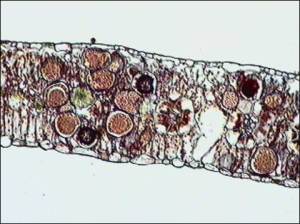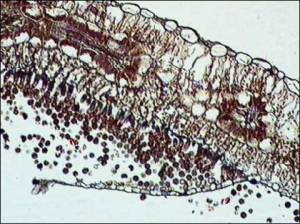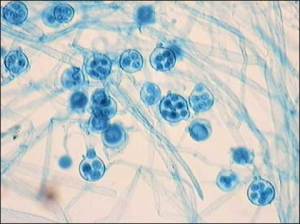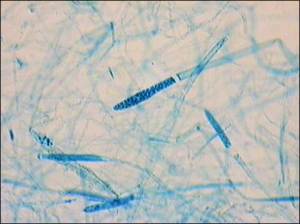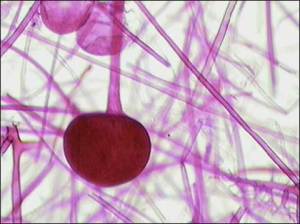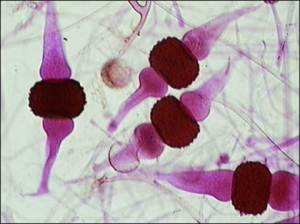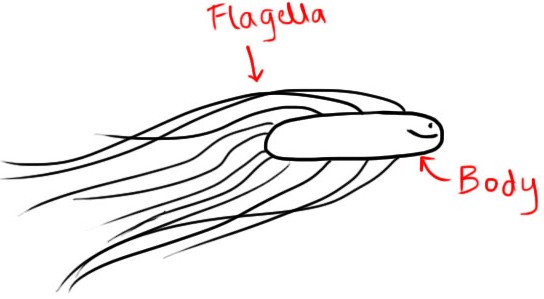Category: Week 2
Taxonomy & Images of Organisms
Cyanobacteria…
Domain: Bacteria
Kingdom: N/A
Phylum: Cyanobacteria
Ocillatoria
Possesses trichomes
Nostoc
Also has trichomes, & a glycocalyx slimelayer
Genus: Gloeocapsa
Single cells with glycocalyx caspules
Genus: Anabaena
Genus: Spirulina
Special Structures –
Heterocysts – Contain enzymes for conducting nitrogen fixation. Nitrogen fixation is the process of bacteria capturing N in gas form w/ enzymes in their body.
Akinetes– It serves as a survival structure. It is a resting cell of cyanobacteria and unicellular and filamentous green algae.[2] Under magnification, akinetes appear thick walled with granular-looking cytoplasms.
Trichomes – Stacks of cells
Fungi
Eurkaryotic Cells
Most are multicellular but some are unicellular
Nutrition – Release digestive enzymes into environment & then absorb nutrients from broken down organic material.
3 Major groups:
- Molds (filamentous)
- Fleshy fungi
- yeasts (unicellular)
Domain – Eukarya
Kingdom – Fungi
Phylum – Oomycota
Albugo bliti
Sexual oospores
&
sporangiospores
Saprolegnia
1st image – oogonium w/ sexual oospores
2nd image – asexual sporangiospores
Phylum: Zygomycota
Rhizopus stolonifer
Wednesday Notes
Lecture….
Bacteria: External Structures
Flagella: Long; used for motility
Fimbriae: Used to attache to other cells & inanimate objects
Pili (penis-ish) – Exchanges DNA
Flagella:
Flagellum (latin for whip)
- Filament – Composed of a protein called flagellin
- Hook – Base of filament near cell wall
- Basal Body – Anchors filament & hook to cell wall
Rotates: 360° turns clockwise (tumbles) & counterclockwise (runs)
Arrangements:
- Petritrichous – flagella cover entire surface
- Polar – Flagella @ one or both ends. Possible more than one.
- Axial Filaments (AKA Endofilaments)- flagella at both ends that spiral around cell between cytoplasmic membrane & outer membrane
Taxis (Movement): Bacterial motility in response to environmental stimuli
Positive: Movement toward stimulus
Negative: Movement away from stimulus
Stimuli:
- Light – Phototaxis
- Chemicals – chemotaxis
Bacterial Cells: Fimbriae & Pili the “penis”
Functions:
- Fimbriae – Attache to other cells & inanimate objects
- Pili – Exchanges genetic information. Composed of pilin (protein)
F + … male cell
F – …female cell
Bacterial Cell Walls:
Walls made of peptidoglycan…
Structures:
- Complex polysaccharides
- Alternating monosaccharide molecules in chains bonded together by polypeptides
- N – Acetylglucosamine (NAG) & N – Acetylmuramic Acid (NAM) these alternate
Tertapeptide holds vertical layers & amino acids connects horizontal layers. (look this up, this a poor explanation)
Gram Positive Cell Walls vs. Gram Negative Cell Walls
Gram-Positive cell walls:
- Cytoplasmic membrane
- multiple layers of peptidoglycan
- teichoic acid (contained in the peptidoglycan)
- acid gives cell wall negative charge
Gram-Negative Cell Walls:
- Cytoplasmic membrane
- Few layers of peptidoglycan
- Outer membrane (phospholipids) – Contains lipo polysaccharieds & a substance called Lipid A which triggers immune system because it is toxic to mammalian cells
Bacteria Cells: Cystoplasmic Membranes
Structure:
- Bilayer of phospholipids
- Proteins: Integral (around); peripheral (inside)
Functions:
- Semi-permeable membrane (some molecule can pass through, not all)
- Protective
- Fluid/semi-fluid
No lab notes today.
Tuesday Notes
Lecture
Nucleic Acid
General Functions:
- Genetic Information storage (DNA)
- Gene Expression (makes product of instructions) (RNA)
- Energy (ATP)
Contains C, H, O, P
RNA vs. DNA
|
RNA |
DNA |
|
|
Nucleotides (Monomers) – A single nucleotide contains ….
1 phosphate group + 1 five-Carbon sugar + 1 nitrogenous base
Nitrogenous Bases: Adenine, Thymine (DNA only), Guanine, Cytosine, Uracil (RNA only)
Polynucleotides (Polymers) – a biopolymer composed of 13 or more nucleotide monomers covalently bonded in a chain. DNA (deoxyribonucleic acid) and RNA (ribonucleic acid) are examples of polynucleotides with distinct biological function
- Phosphodiester bonds- In DNA and RNA, the phosphodiester bond is the linkage between the 3′ carbon atom of one sugar molecule and the 5′ carbon atom of another; the sugar molecules being deoxyribose in DNA and ribose in RNA. (This explanation is slightly confusing…essentially this is the bond the forms between each nucleotide linking them together to form polynucleotides)
- H – Bonds – Formed between the “teeth” of the polynucleotides connecting one to another polynucleotide to form a helix of DNA. H-bonds allow for DNA to split easily.
ATP – energy molecule for cells, this energy is released when a phosphate group breaks away.
As each phosphate group breaks away it becomes ADP and then AMP (the middle letter stands for the quantity of phosphate groups)
Overview of Cells
Cell Theory:
- All living things are made of cells Cells are the smallest (basic) units of life. (Theordore Shwann & Jakob Shleiden, 1839)
- All cells come from preexisting cells. (relates back to biogenesis theory; Rudolph Virchow, 1855)
* = bacteria differs from Archaea
|
ARCHAEA |
BACTERIA |
EUKARYA |
| No True Nucleus | No True Nucleus | Nucleus |
| No Membranous Organelles | No Membranous Organelles | Membranous Organelles |
| Hami (cell extension) | *No Hami | No Hami |
| Cell walls (most) have no peptidoglycan | *Cell walls contain peptidoglycan | Some contain peptidoglycan (cellulose, chiten) |
| No Endospores | *Endospores (some) | No Endospores |
| 70s ribosome’s(s= Svedberg unit; sedimentation rate) |
80s ribosome’s (except mitochandria & chloroplasts = 70s)
Single circular chromosome Single circular chromosome Most have multiple linear chromosomes.
Bacterial Cells: External Structures
Glycocalyx – Gelatinous material composed of polysaccharides &/or polypeptides
2 Forms:
- Capsule – Well organized & firmly attached to the cell.
- Slimelayer (Biofilms) – Loose, less organized & NOT firmly attached to the cell.
Lab
We covered:
Endospore stain
This is a structural stain.
- Endospore – Small dormant cells produced by many species of bacteria that are super resistant to heat, dry conditions, & toxic chemicals.
Rules of endospores:
- Produced in response to stressful environmental conditions (such as those I listed above)
- ONE endospore is produced by each cell; location will be central or terminal.
- Terminal – Will be found at the head/tail of the bacteria (inside)
- Central – In the center (hence, central) of the bacteria (inside)
- Endospores resist staining; but retain the stain once it binds to the cells.
Overall point of this stain is to determine whether your organisms produces endospores or not. We mainly saw exospores today because our samples were too old. Meaning our bacteria cultures had been stressed a few days ago, they created endospores and then released them outside the cell creating exospores. Our cells were vegetative, our exospores & endospores were dormant small dormant cells waiting for good conditions again to blossom in.
Endospore Stain Process…
Stains used:
- Malachite Green -The green is used to color the endospores, so if you had endospores they should have been green in your slide!!! We reapplied water as necessary not to dry out our paper towels.
- Safranin – COUNTERSTAIN – colors your vegetative cells pink.
- Water + Culture smear
- Air dry & heat fix (not too much)
- Steam
- Apply Malachite Green drops to paper towels. (endospore staining)
- Keep moist with drops of water as necessary for 15 minutes!
- Rinse slide (decoloration step)
- Counter stain with Safranin, 60 seconds. (cell staining)
- Rinse slide & air dry
Capsule Stain
Capsule Stain: Structural Stain
Capsules – Highly organized structures made of glycocalyx. Capsules protect some of these bacteria from being destroyed by a host’s immune system.
Glycocalyx – Gelatinous material composed of polysaccharide &/or polypeptides. Ex. slime on the outside of a fish is considered a glycocalyx.
Glycocalyx comes in 2 forms:
- Capsule – This is the highly organized structure we are testing for.
- Slimelayer – Another form (biolfilm) not being tested.
Capsule Stain Process… (non-heat fix)
Stains/Chemicals used: Nigrosin; Isopropyl alcohol; Crystal violet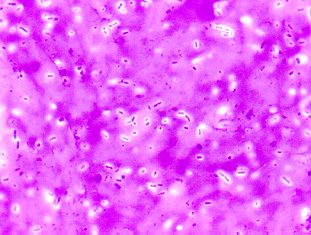
- Prepare smears w/ water & bacteria
- While wet add Nigrosin
- Air dry
- Add Isopropyl acohol; 2 min – this step fixes (kinda) the cells to slide
- No rinse…Air dry
- Crystal Violet for 2 min
- GENTLY rinse with water
- Air dry
Results: Cells will be purple and capsules (if present) will be a clear area around cells
Here goes quiz 3…. anyone exhausted yet? I am. I will try to get the practice questions up tonight for quiz tomorrow.
Monday Notes
Lecture
Found a site w/ good pictures http://www.chemistar.com/Biology/organicmolecules.html
Lipids
General Functions:
- Provide energy (9 cal/gram compared to carbs & proteints at 4cal/gram)
- Provide structure (ex. cell membranes)
- Some are hormones. (ex. estrogen, testosterone)
Contain C, H, O
Sources – Fats, oils, waxes, phospholipids (part of cell membranes), steroids.
Fats are a subgroup of Triglycerides – a typical triglyceride molecule is found in oils (plants) & fats (animals).
ex. 1 glycerol + 3 fatty acids = 1 triglyceride (ester bond- connects glycerol to fatty acids)
Subgroups of Lipids…
Fats:
Saturated: maximum # of Hydrogen attached to each carbon. (no double bonds between Carbon atoms)
Monounsaturated: has only one double bond in the chain. Therefore, fewer Hydrogens & a kink in the chain. (Oleic Acid)
Polyunsaturated:2 + double bonds in the chain. Also, has less Hydrogen & more kinks in the chain. (Linoleic Acid)
Phospholipids: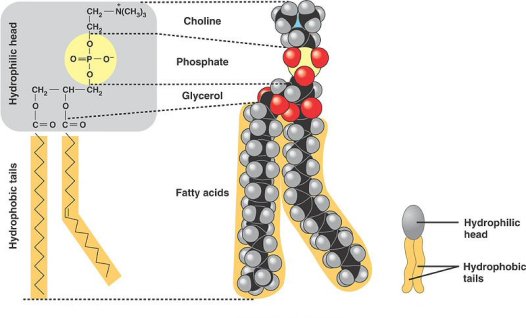
1 glycerol + 2 fatty acids + 1 phosphate group + 1 organic functional group = phospholipid
Phosphate groups – Interacts with water; because the phosphate head is polar.
Fatty acid ‘legs’ – Non-polar, do not interact with water and align themselves together to be protected from the water while exposing the phosphate groups to the water.
Steroids:
- Contain 4 fused rings
- Include cholesterol (found in cell membranes of animals)
Proteins
General Functions:
- Structural
- Involved in cell communications (ex. hormones)
- Catalysts for chemical RXNs (enzymes)
Contains C, H, N, O (S)
Protein Monomers: Amino Acids – Single amino acids contains a central carbon, carboxyl group(COOH), amino group (NH2) & side group (R-group). 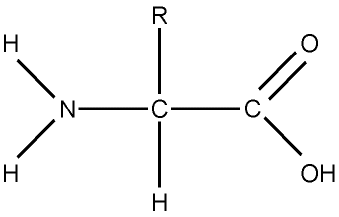
- R-group: Glutamine; Serine
Polypeptides (Polymers): 2+ amino acids linked together.
- Peptide Bonds- Protein covalent bonds
- DNA provides the instructions to make (LARGE CHAINS) proteins; they are made inside the cell linking one amino acid to another.
- Each protein has a unique combination of amino acids
- 20 different types of amino acids formed in living things.
Levels of Protein Structure:
- Primary – The specific order of amino acids in a polypeptide chain.
- Secondary – Hydrogen bonds form between the carboxyl groups & amino groups. This stage forms β -pleated sheets & α-helices throughout the polypeptides.
- Tertiary – Additional bonding occurs involving R-groups to make simpe proteins (one peptide chain) functional.
- Quaternary – Additional bonding occurs between more than one polypeptide chain to make functional protein (complex)
Ex. of importance of primary structure:
- Prion that causes Scrapie (sheep) : Alanine is substituted for valine and #136 resulting in a mis-fold of proteins.
- Sickle Cell Disease (humans): Valine gets substituted for glutamate @ # 6 in hemoglobin. Valine does not interact well w/ water causing it to crystalize and form a deformed cell.
Protein Denaturation – The loss of tertiary or quaternary structure, resulting in a loss of function. Causes are high heat, alcohol, some metals and/or acids.
Extra Credit: Smith Lemli Opitz Syndrome – an autosomal recessive metabolic and developmental congenital disorder that causes the inability to correctly produce or synthesize cholesterol due to a low occurrence of the 7-DHC reductase enzyme.
Only a few of the symptoms:
- Small head size (microcephaly)
- Mental retardation
- Learning disabilities and behavioral problems
- Malformations of the heart, lungs, kidneys, gastrointestinal tract, and genitalia
- Hypocholesterolemia
- Paleness
- Low muscle tone (hypotonia)
Lab
Gram Stain
Q: Is my bacteria gram positive or gram negative?
A: Use a gram stain… Thanks to Hans Gram in 1884 we have a differential stain technique that distinguishes cells based on content of cell walls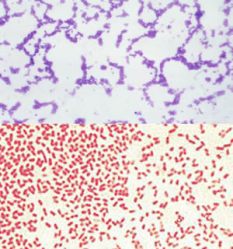
Purple colored cells = gram positive
- Gram Positive Cells – have thick peptidoglycan (multiple layers) that contains teichoic acid
Pink colored cells = gram negative
- Gram Negative Cells – Thin peptidoglycan (few layers) with outer membrane that contains lipopolysaccharides (toxic to mammalian cells)
KOH Test
Can be used to identify Gram-Positive vs. Gram-Negative cells. Potassium Hydroxide causes Gram – Negative cells to lyse (busrt), releasing a viscous liquid. (It will be ‘snotty-like’) Gram-positive cells do not lyse when mixed with KOH, so the liquid remains thin/non-viscous.
Acid Fast Stain
Q: Does the unknown bacteria have mycolic acid (was like substance) in its cell walls?
A: Use an acid fast stain.
Note: Mycolic acid is only found in gram positive cells, but not all gram positive cells have mycolic acid.

